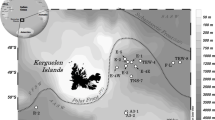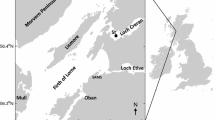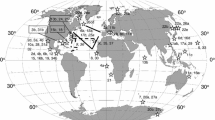Abstract
About 560 literature data on weight-specific ammonia excretion rates of gelatinous zooplankton (cnidarians, ctenophores and salps) and non-gelatinous zooplankton (mainly crustacea) were converted to carbon based units to enabel a better comparison between both groups. If carbon is used as body-mass unit ammonia excretion rates of gelatinous zooplankton are in the same range as values obtained for other zooplankton taxa, indicating a similar nitrogen output per unit of organic matter in both groups. These results suggest nutrient regeneration potential to be the same in gelatinous and non-gelatinous zooplankton, and that nutrient regeneration within the pelagic system depends more upon the carbon biomass ratio between gelatinous and other zooplankton than on physiological differences.
Similar content being viewed by others
Literature cited
Alldredge, A. L. (1984). The quantitative significance of gelatinous zooplankton as pelagic consumers. In: Fasham, M. J. R. (ed.) Flows of energy and materials in marine ecosystems: theory and practice. Plenum Press, New York, p. 407–433
Andreu-Puyal, R., Santamaria, G., Trepat, I. (1975). Distribution de quelques groupes de zooplancton (Euphausiáces, Ptéropodes—Hétéropodes, Salpides, Doliolides et Appendiculaires) dans le N.O. africain. Cons. perm. Int. Explor. Mer, CM/L 16
Båmstedt, U. (1985). Seasonal excretion rates of macrozooplankton from the Swedish west coast. Limnol. Oceanogr. 30: 607–617
Bathmann, U. V. (1988). Mass occurrence ofSalpa fusiformis in the spring of 1984 off Ireland: implications for sedimentation processes. Mar. Biol. 97: 127–135
Biggs, D. C. (1977). Respiration and ammonium excretion by open ocean gelatinous zooplankton. Limnol. Oceanogr. 22: 108–117
Biggs, D. C. (1982). Zooplankton excretion and NH4 +-cycling in near surface waters of the southern ocean. I. Ross Sea, austral summer 1977–1978. Polar Biol. 1: 55–67
Biggs, D. C., Bidigare, R. R., Smith, D. E. (1981). Population density of gelatinous macrozooplankton: in situ estimation in oceanic surface waters. Biol. Oceanogr. (N.Y.) 1: 157–172
Binet, D. (1970). Apercu sur les variations saisonières du zooplankton et plus particulièrement des copépodes du plateau continental de Pointe-Noire (Congo). Docums scient Centre O.R.S.T.O.M., Pointe-Noire 8: 1–109
Cetta, C. M., Madin, L. P., Kremer, P. (1986). Respiration and excretion by oceanic salps. Mar. Biol. 91: 529–537
Cushing, D. H., Humphrey, G. F., Banse, K., Laevastu, T. (1958). Report of the committee on terms and equivalents. Rapp. P.-v. Réun. Cons. perm. int. Explor. Mer 144: 15–16
Dugdale, R. C., Goering, J. J. (1967). Uptake of new and regenerated forms of nitrogen in primary productivity. Limnol. Oceanogr. 12: 196–206
Eppley, R. W., Renger, E. H., Venrick, E. L., Mullin, M. M. (1973). A study of plankton dynamics and nutrient cycling in the central gyre of the North Pacific Ocean. Limnol. Oceanogr. 18: 534–551
Fraser, J. H. (1961). The oceanic and bathypelagic plankton of the north-east Atlantic and its possible significance to fisheries. Mar. Res. 1961 (4): 1–48
Haeckel, E. (1879). Das System der Medusen. Erster Theil einer Monographie der Medusen. Gustav Fischer Verlag, Jena
Haeckel, E. (1890). Plankton Studien. Vergleichende Untersuchung über die Bedeutung und Zusammensetzung der pelagischen Fauna und Flora. Gustav Fischer Verlag, Jena
Hamner, W. M., Schneider, D. (1986): Regularly spaced rows of medusae in the Bering Sea: Role of Langmuir circulation. Limnol. Oceanogr. 31: 171–177
Harbison, G. R., Madin, L. P., Swanberg, N. R. (1978). On the natural history and distribution of oceanic ctenophores. Deep-Sea Res. 25: 233–256
Härdstedt-Roméo, M. (1982). Some aspects of the chemical composition of plankton from the North-Western Mediterranean Sea. Mar. Biol. 70: 229–236
Hubbard, L. T., Pearcy, W. G. (1971). Geographic distribution and relative abundance of Salpidae off the Oregon coast. J. Fish Res. Bd Can. 28: 1831–1836
Ikeda, T. (1974). Nutritional ecology of marine zooplankton. Mem. Fac. Fish. Hokkaido Univ. 22: 1–97
Ikeda, T. (1977). The effect of laboratory conditions on the extrapolation of experimental measurements to the ecology of marine zooplankton. IV. Changes in respiration and excretion rates of boreal zooplankton species maintained under fed and starved conditions. Mar. Biol. 41: 241–252
Ikeda, T. (1985). Metabolic rates of epipelagic marine zooplankton as a function of body mass and temperature. Mar. Biol. 85: 1–11
Ikeda, T., Bruce, B. (1986). Metabolic activity and elemental composition of Krill and other zooplankton from Prydz Bay, Antarctica, during early summer (November–December). Mar. Biol. 92: 545–555
Ikeda, T., Mitchell, A. W. (1982). Oxygen uptake, ammonia excretion and phosphate excretion by Krill and other antarctic zooplankton in relation to their body size and chemical composition. Mar. Biol. 71: 283–298
Ikeda, T., Skjoldahl, H. R. (1989). Metabolism and elemental composition of zooplankton from the Barents Sea during early arctic summer. Mar. Biol. 100: 173–183
Jawed, M. (1973). Ammonia excretion by zooplankton and its significance to primary productivity during summer. Mar. Biol. 23: 115–120
Kremer, P. (1976). Excretion and body composition of the ctenophoreMnemiopsis leidyi (A. Agassiz): comparisons and consequences. Proc. 10th Eur. mar. Biol. Symp. 2: 351–362 [Persoone, G., Jaspers, F. (eds.) Universa Press, Wetteren, Belgium]
Kremer, P. (1977). Respiration and excretion by the ctenophoreMnemiopsis leidyi. Mar. Biol. 44: 43–50
Kremer, P. (1982). Effect of food availability on the metabolism of the ctenophoreMnemiopsis mccradyi. Mar. Biol. 71: 149–156
Kremer, P., Canino, M. F., Gilmer, R. W. (1986). Metabolism of epipelagic tropical ctenophores. Mar. Biol. 90: 403–412
Kroll, L. (1979). Untersuchungen über die Stickstoff- und Phosphor-Exkretion von Brackwassercopepoden. Thesis, Kiel University, Kiel
Krüger, F. (1968). Stoffwechsel und Wachstum bei Scyphomedusen. Helgoländer wiss. Meeresunters. 18: 367–383
Larson, R. J. (1986). Water content, organic content, and carbon and nitrogen composition of medusae from the Northeast Pacific. J. exp. mar. Biol. Ecol. 99: 107–120
Muscatine, L., Marian, R. E. (1982). Dissolved inorganic nitrogen flux in symbiotic and non-symbiotic medusae. Limnol. Oceanogr. 27: 910–917
Omori, M. (1969). Weight and chemical composition of some important oceanic zooplankton in the North Pacific Ocean. Mar. Biol. 3: 4–10
Purcell, J. (1985). Predation of fish eggs and larvae by pelagic cnidarians and ctenophores. Bull. mar. Sci. 37: 739–755
Raymont, J. E. G: (1983). Plankton and productivity in the oceans. II. Zooplankton. Pergamon Press, Oxford
Roger, C. (1988). Recyclage des sels nutritifs par le macroplancton-micronecton dans le Pacifique tropical Sud-Ouest. Oceanol. Acta 11: 107–116
Schneider, G. (1989a). Carbon and nitrogen content of marine zooplankton dry material; a short review. Plankton Newsletter 11: 4–7
Schneider, G. (1989b). The common jellyfishAurelia aurita: standing stock, excretion and nutrient regeneration in the Kiel Bight/Western Baltic. Mar. Biol. 100: 507–514
Shenker, M. J. (1984). Scyphomedusae in surface waters near the Oregon coast, May–August, 1981. Estuar. cstl Shelf. Sci. 19: 619–632
Smith, S. L. (1978). Nutrient regeneration by zooplankton during a red tide off Peru, with notes on biomass and species composition of zooplankton. Mar. Biol. 49: 125–132
Smith, S. L., Whitledge, T. E. (1977). The role of zooplankton in the regeneration in a coastal upwelling system off northwest Africa. Deep-Sea Res. 24: 49–56
Veer, H. W., van der, Oortuysen, W. (1985). Abundance, growth and food demand of the scyphomedusaAurelia aurita in the Western Wadden Sea. Neth. J. Sea Res. 19: 38–44
Verity, P. (1985). Ammonia excretion rates of oceanic copepods and implications for estimates of primary production in the Sargasso Sea. Biol. Oceanogr. (N.Y.) 3: 249–283
Weisse, T. (1985). Die Biomasse und Stoffwechselaktivität des Mikro- und Mesozooplanktons in der Ostsee. Ber. Inst. MeeresK de Kiel 144: 1–127
Wiebe, P. H., Madin, L. P., Haury, L. R., Harbison, G. R., Philbin, L. M. (1979). Diel vertical migration bySalpa aspera and its potential for large-scale particulate organic matter transport to the deep-sea. Mar. Biol. 53: 249–255
Author information
Authors and Affiliations
Additional information
Communicated by O. Kinne, Oldendorf/Luhe
Rights and permissions
About this article
Cite this article
Schneider, G. A comparison of carbon based ammonia excretion rates between gelatinous and non-gelatinous zooplankton: Implications and consequences. Mar. Biol. 106, 219–225 (1990). https://doi.org/10.1007/BF01314803
Accepted:
Issue Date:
DOI: https://doi.org/10.1007/BF01314803




